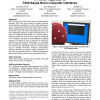Free Online Productivity Tools
i2Speak
i2Symbol
i2OCR
iTex2Img
iWeb2Print
iWeb2Shot
i2Type
iPdf2Split
iPdf2Merge
i2Bopomofo
i2Arabic
i2Style
i2Image
i2PDF
iLatex2Rtf
Sci2ools
IUI
2010
ACM
2010
ACM
A POMDP approach to P300-based brain-computer interfaces
Most of the previous work on non-invasive brain-computer interfaces (BCIs) has been focused on feature extraction and classification algorithms to achieve high performance for the communication between the brain and the computer. While significant progress has been made in the lower layer of the BCI system, the issues in the higher layer have not been sufficiently addressed. Existing P300-based BCI systems, for example the P300 speller, use a random order of stimulus sequence for eliciting P300 signal for identifying users’ intentions. This paper is about computing an optimal sequence of stimulus in order to minimize the number of stimuli, hence improving the performance. To accomplish this, we model the problem as a partially observable Markov decision process (POMDP), which is a model for planning in partially observable stochastic environments. Through simulation and human subject experiments, we show that our approach achieves a significant performance improvement in terms of th...
IUI 2010 | Markov Decision Process | Non-invasive Brain-computer Interfaces | Observable Markov Decision | Software Engineering |
| Added | 17 Mar 2010 |
| Updated | 17 Mar 2010 |
| Type | Conference |
| Year | 2010 |
| Where | IUI |
| Authors | Jaeyoung Park, Kee-Eung Kim, Sungho Jo |
Comments (0)

